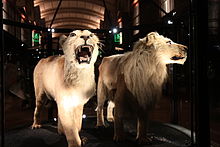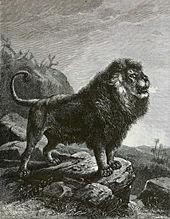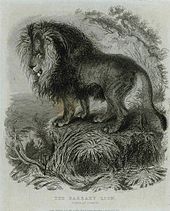
Barbary lion
Did you know...
This Schools selection was originally chosen by SOS Children for schools in the developing world without internet access. It is available as a intranet download. Before you decide about sponsoring a child, why not learn about different sponsorship charities first?
| Barbary lion | |
|---|---|
 |
|
| A Barbary lion from Algeria, photographed by Sir Alfred Edward Pease around 1893 | |
| Conservation status | |
 Extinct in the Wild ( IUCN 3.1) |
|
| Scientific classification | |
| Kingdom: | Animalia |
| Phylum: | Chordata |
| Class: | Mammalia |
| Order: | Carnivora |
| Family: | Felidae |
| Genus: | Panthera |
| Species: | P. leo |
| Subspecies: | P. l. leo |
| Trinomial name | |
| Panthera leo leo (Linnaeus, 1758) |
|
| Synonyms | |
|
Felis leo Linnaeus, 1758
Panthera leo berberisca |
|
The Barbary lion (Panthera leo leo), also known as the Atlas lion is a subspecies of lion that became extinct in the wild in the 20th century. Its former habitat range was in North Africa encompassing the region from Morocco to Egypt.
Description
The Barbary lion is often regarded as the largest and the heaviest of the lion subspecies with estimated weights for males of 190 to 230 kilograms (420 to 510 lb) and for females of 150 to 190 kilograms (330 to 420 lb). These weight ranges have been criticized for being greatly exaggerated, however, with the Barbary lion being considered similar in size to the lions in East Africa. Male Barbary lions were around 2.7 to 3.4 metres (8 ft 10 in to 11 ft 2 in) in length and females were around 2.1 to 2.7 metres (6 ft 10 in to 8 ft 10 in) in length.
Unlike other lion subspecies, the Barbary lion did not live in prides due to the scarcity of food in its habitat. These lions were solitary like the other big cat species, or occasionally lived in pairs. Females raised their young until maturity - approximately 2 years - and then separated from them.
Diet
The main sources of natural prey for the predators of the Atlas Mountains were Barbary Stag and gazelle. Another particular favorite, and somewhat easier target, were the herds of cows and sheep kept by man. The method of hunting was never documented, but it is believed that they used the same death by strangulation method as do the other big cats of the world.
Relationship with humans
The Romans used Barbary lions in the Colosseum to battle with Gladiators. In the Middle Ages, the lions kept in the menagerie at the Tower of London were Barbary lions, as shown by DNA testing on the two well-preserved skulls excavated at the Tower in 1937. The skulls have been radiocarbon dated to 1280-1385 AD and 1420-1480 AD. Dr Nobuyuki Yamaguchi of the Wildlife Conservation Unit at the University of Oxford said the growth of civilizations along the Nile and in Sinai Peninsula by the beginning of the second millennium BC stopped genetic flow by isolating lion populations. Desertification also prevented the Barbary lions from mixing with lions located further south in the continent. The lion survived in the wild in northwestern Africa in what is now current day Libya, Tunisia, Algeria and Morocco until about 1922.
Historically Barbary lions were offered in lieu of taxes and as gifts to royal families of Morocco and Ethiopia. The rulers of Morocco kept these 'royal lions' through war and insurrection, splitting the collection between zoos when the royal family went into exile briefly; some were returned to the palace when the exiled ruler returned to the throne. After a respiratory disease nearly wiped out the royal lions, the current ruler established the Temara Zoo in Rabat, Morocco to house the lions and improve their quality of life. There remains a handful of 'royal lions' to this day that have the right pedigree and physical characteristics to be considered mostly-pure Barbary descendents.
In the 19th century and the early 20th century Barbary lions were often kept in hotels and circus menageries. The lions in the Tower of London were transferred to more humane conditions at the London Zoo in 1835, on the orders of the Duke of Wellington. One famous purebred Barbary lion named "Sultan" lived in the London Zoo in 1896.
Emperor Haile Selassie I of Ethiopia kept Barbary lions at his court.
Extinction in the wild
The Barbary lion first became extinct in Tripoli in 1700, then in Tunisia in 1891, Algeria in 1899, and finally, the last known Barbary lion in the wild was shot and killed in the Atlas Mountains in Morocco in 1922.
The Barbary lion is believed to be extinct in captivity as well. However, possible Barbary lion individuals or descendants have allegedly been located in zoos and circus populations within the last three decades, but this has not been confirmed genetically. The two other primary predators of northern Africa, the Atlas bear and Barbary leopard, are now also extinct, and close to extinction, respectively.
Possible survivors
Currently several dozen individuals in captivity are claimed to be Barbary lions. In the past scientists believed that the distinct subspecies status of the Barbary lion was established by its seemingly fixed external morphology, particularly its heavier mane. However, it is now known that various extrinsic factors influence the colour and size of all lions' manes, such as ambient temperature. As the cooler ambient temperature in European and North American zoos has been found to produce Barbary-like manes in other lion subspecies, this characteristic is now considered an inappropriate marker for identifying Barbary ancestry.
Mitochondrial DNA research published in 2006 supports the distinctness of the Barbary lions as a subspecies. The results found a unique mtDNA haplotype to be present in some of those museum specimens believed to be of Barbary descent. This may be a good molecular marker for identifying—and excluding—other potential Barbary lions. The mtDNA results revealed that five tested samples of lions from the famous collection of the King of Morocco are not, according to this criterion, maternally Barbary. However, in the same year, mtDNA research revealed that a lion specimen from Neuwied Zoo (which originated from the collection of the King of Morocco) is not of sub-Saharan origin according to its mitochondrial lineage and, thus, very likely a descendant of a Barbary lion.
In 2008, in a major study published in PLOS Genetics, it was found that four "Atlas" lions from Morocco did not exhibit any unique genetic characteristics. However, the Moroccan cats shared mitochondrial haplotypes (H5 and H6) with central African lions, and together with them were part of a major mtDNA grouping (lineage III) that also included Asiatic samples. According to the authors, this scenario was in line with their theories on lion evolution. They conclude that lineage III developed in east Africa, and then travelled north and west in the first wave of lion expansions out of the region some 118,000 years ago. It apparently broke up into haplotypes H5 and H6 within Africa, and then into H7 and H8 in west Asia.
While the historical Barbary lion was morphologically distinct, its genetic uniqueness remains questionable, and the taxonomic status of surviving lions frequently considered as Barbary lions, including those that originated from the collection of the King of Morocco, is still unclear.
Nonetheless, genes of the Barbary lion are likely to be present in common European zoo lions, since this was one of the most frequently introduced subspecies. Therefore many lions in European and American zoos, which are managed without subspecies classification are in fact partly descendants of the Barbary lion.
The Barbary Lion Project
The former popularity of the Barbary Lion as a zoo animal provides the only hope to ever see it again in the wild in North Africa. Many zoos provide mating programmes, which will help to increase the population of the species.
After years of research into the science of the Barbary Lion and stories of surviving examples, WildLink International, in collaboration with Oxford University, launched their ambitious International Barbary Lion Project. They are using the very latest DNA techniques to identify the DNA 'fingerprint' of the Barbary Lion subspecies. WildLink International has taken bone samples from remains of Barbary Lions in museums across Europe, like those in Brussels, Paris, Turin and others. These samples are returned to Oxford University where the science team is extracting the DNA sequence that identifies the Barbary as a separate subspecies.
Although the Barbary may be extinct, and is certainly extinct in the wild, WildLink International identified a handful of lions in captivity around the world that may be descended from the original Barbary Lion. These descendants will be tested against the DNA fingerprint and the degree of any hybridization (from crossbreeding) can then be determined. The best candidates will then enter a selective breeding programme slated to ' breed back' the Barbary Lion. The final phase of the project will see the lions released into a National Park in the Atlas Mountains of Morocco.
As of March 2010, two alleged barbary lion cubs have been moved to 'The Texas Zoo' in Victoria, Texas where efforts are being made to preserve the endangered species under the WildLink International conservation programme.





